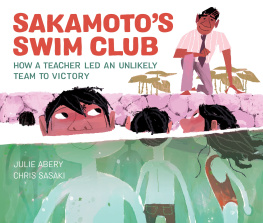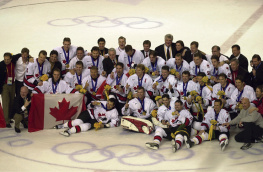For Jim, who believed J.A.
For Grandma Irene C.S.
With special thanks to Coach Keith Arakaki of the Hawaii Swimming Club, Nelson Okino of the Japanese Cultural Center of Hawaii, Holly Buland of the Alexander & Baldwin Sugar Museum and Kai Duponte.
ISBN 978-1-5253-0788-1 (EPUB)
Text 2021 Julie Abery Illustrations 2021 Chris Sasaki
All rights reserved. No part of this publication may be reproduced, stored in a retrieval system or transmitted, in any form or by any means, without the prior written permission of Kids Can Press Ltd. or, in case of photocopying or other reprographic copying, a license from The Canadian Copyright Licensing Agency (Access Copyright). For an Access Copyright license, visit www.accesscopyright.ca or call toll free to 1-800-893-5777.
Published in Canada and the U.S. by Kids Can Press Ltd. Dockside Drive, Toronto, ON M5A 0B5
Kids Can Press is a Corus Entertainment Inc. company
www.kidscanpress.com
The artwork in this book was rendered digitally in Photoshop. This ebook edition has been created using CircularFLO from Circular Software.
Edited by Jennifer Stokes Designed by Marie Bartholomew
Library and Archives Canada Cataloguing in Publication
Title: Sakamotos swim club : how a teacher led an unlikely team to victory / written by Julie Abery ; illustrated by Chris Sasaki.
Names: Abery, Julie, author. | Sasaki, Chris (Illustrator), illustrator.
Identifiers: Canadiana 20200227165 | ISBN 9781525300318 (hardcover)
Subjects: LCSH: Sakamoto, Soichi, 19061997 Juvenile literature. | LCSH: Swim teams Hawaii Maui History Juvenile literature. | LCSH: Swimming Hawaii Maui History Juvenile literature.
Classification: LCC GV838.4.U6 A23 2021 | DDC j797.2/1096921 dc23
Kids Can Press gratefully acknowledges that the land on which our office is located is the traditional territory of many nations, including the Mississaugas of the Credit, the Anishnabeg, the Chippewa, the Haudenosaunee and the Wendat peoples and is now home to many diverse First Nations, Inuit and Mtis peoples.
We thank the Government of Ontario, through Ontario Creates; the Ontario Arts Council; the Canada Council for the Arts; and the Government of Canada for supporting our publishing activity.
Preface
Who would believe that children cooling off in the irrigation ditches of sugar plantations on the Hawaiian island of Maui could become Olympic swimming champions?
Science teacher Soichi Sakamoto believed. He was determined to make a difference in their lives. With Sakamotos guidance, Mauis swimmers surged onto the national scene and dominated events both in the United States and across the world. This included two Olympic gold medals won by Bill Smith in the 1948 London games.
Almost lost to history, the story of Sakamotos swim club is an inspiration to athletes around the world.
Valley Isle. Lush terrain. Migrant workers cutting cane.
Dawn to dusk they toil away. Children left alone to play.
Melting in the midday sun, diving, swimming, having fun.
Run! Policemans on his beat. Children scatter in the heat.
Sakamoto takes a stand, offering a guiding hand.
He makes the case for kids to train, using ditch as swimming lane.
Daily program. Strict regime. Use resistance. Swim upstream.
Science teachers new approach turns him into master coach.
Ditch to pool. Plan is clearer. Sakamotos dream grows nearer.
Swimmers share Olympic dream. Three-Year Swim Club forms the team.
Make their entrance, bright and loud. Mauis swimmers draw a crowd.
But tension knocks at Europes door. Olympic hopes crushed by war.
Dawn raids shatter peaceful skies. Athletes answer countrys cries.
Dream awakes in forty-eight. Poised on blocks, swimmers wait.
In the bleachers full of pride, Sakamotos tense inside.
Starting gun. Bill dives clear.
Stroke by stroke, he shows no fear.
Pace, rhythm, strength, speed come together to succeed.
Mauis swimmer breaks the mold.
On the rostrum, taking gold.
The anthem plays. People cheer. Sakamoto wipes a tear.
In Maui, also known as the Valley Isle, streams rush down lush mountain slopes. In the 1930s, water tumbled to the valley and flowed into irrigation ditches that nourished the islands sugar plantations. While workers toiled in the sugar cane fields, their children dipped and dived in the murky water of the ditches.
Authors Note
Coach Sakamoto (far right) with the Three-Year Swim Club. From the collection of the Alexander & Baldwin Sugar Museum.
From his classroom window, a local science teacher named Soichi Sakamoto would watch the children swim. Then he would hear the clip-clopping of the plantation policemans horse, and sigh as barefoot children scattered through the countryside to escape the officers whip.
Sakamoto decided to speak to the owners of the Hawaiian Commercial and Sugar Company, offering to take responsibility for the children if the company would allow them to keep swimming in the irrigation ditches.
Every day after school, Sakamoto coached his ditch swimmers. Although not a good swimmer himself, he researched swimming strokes and applied his science background to come up with innovative training techniques. He ran alongside the kids, shouting instructions to improve their pace and rhythm, and used the waters natural current to increase their strength and speed. The swimmers learned to trust Sakamotos coaching as their skills steadily improved. They worked hard each day, pushing themselves to swim better, faster and longer.
When the Hawaiian Commercial and Sugar Company built the community a pool and park, Sakamoto and his young charges spent every possible minute of every day training there. Sakamoto had a dream and he would need his swimmers commitment to make it come true. He called a meeting in his classroom. Would they agree to a tough three-year training schedule to compete at the 1940 Olympics?
That day, the Three-Year Swim Club was born. Their motto: Olympics first, Olympics always.
Mauis swimmers began to dominate at swim meets both in and out of the pool. They sported bright, colorful shirts, traditional straw hats and flower leis.
They entertained the press, singing Hawaiian songs with Sakamoto accompanying them on the ukulele. They were proud of their heritage. Their pride gave them strength.
Maui swimmers had never won a major championship, but, in 1939, Sakamotos team surprised everyone by winning the National Championship in Detroit, Michigan. Now they were ready for the upcoming Olympics in Helsinki, Finland. But tensions were building in Europe and, in September 1939, World War II began. The Olympic Games were canceled.
When the United States entered the war in 1941, Coach Sakamoto watched many of his athletes bravely answer the call to serve their country. Like a father, he wrote letters to each of them.
Finally, in 1948 London, Sakamotos impossible dream came true. Standing in the bleachers, with the crowd cheering wildly, the Three-Year Swim Clubs own Bill Smith took a glorious win in the 400-meter freestyle race an Olympic record and Olympic gold!
Affectionately known as Coach to his team, Sakamotos legacy continued, with many of his swimmers going on to achieve national and international success, including more Olympic medals in 1952 and 1956. Sakamoto dedicated his life to mentoring hundreds of Hawaiis children. His goal was to make them the best they could be and give them opportunities for travel and education. Sakamoto was inducted into the International Swimming Hall of Fame in 1966.
Resources
Arakaki, K. Missus. Hawaii Swim . May 1992. http://www.hawaiiswim.org/legacy/hscMiss.html
Coach Soichi Sakamoto. Swimming Hall of Fame . http://www.hawaiiswim.org/legacy/coach.html
Next page





